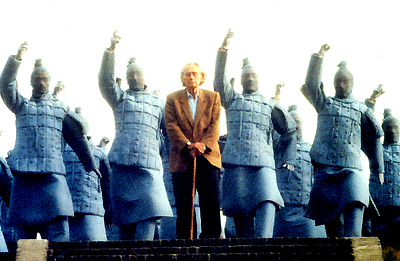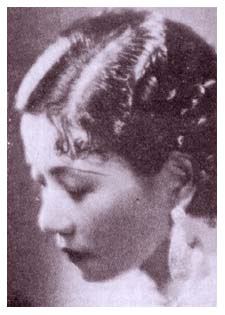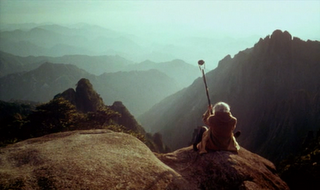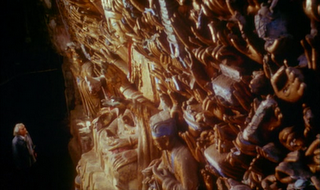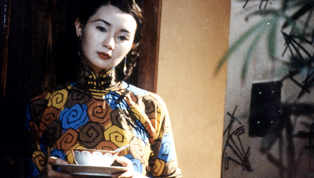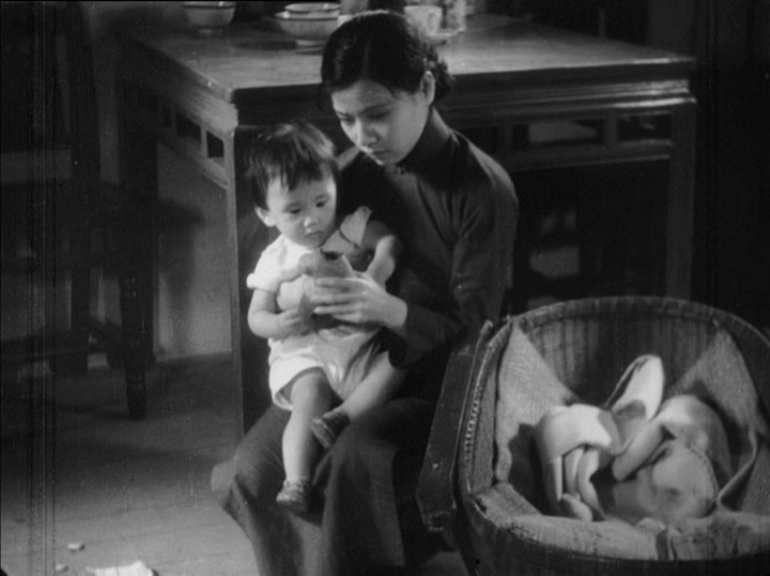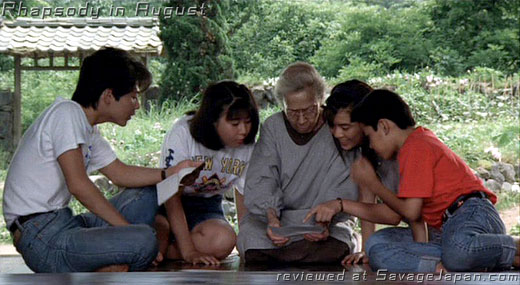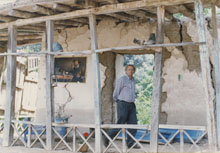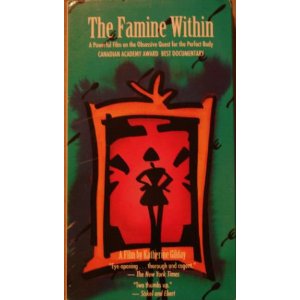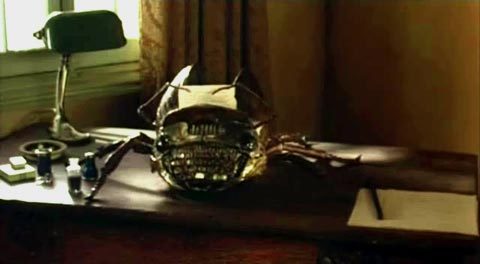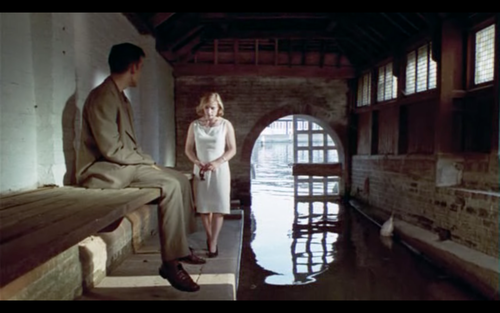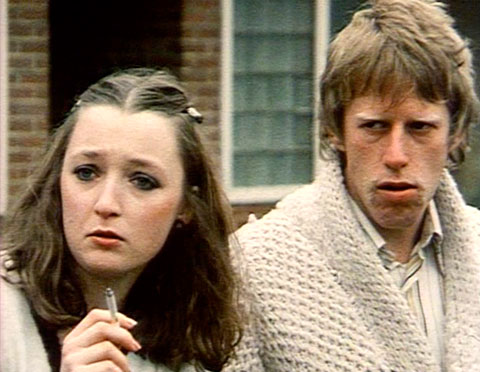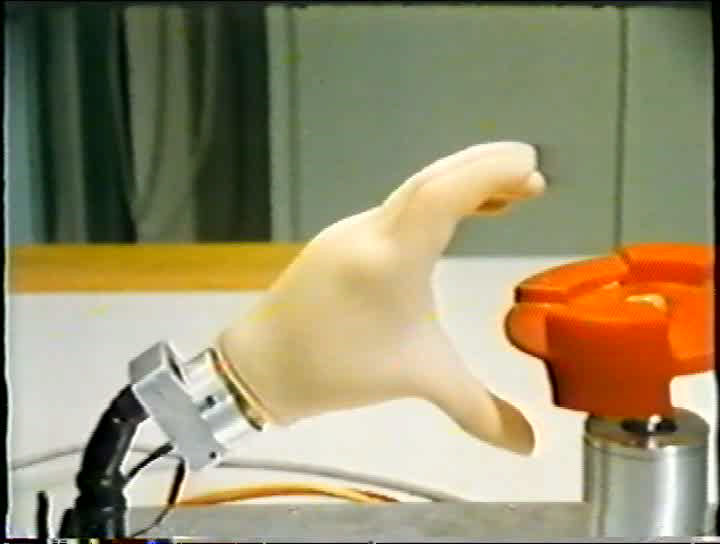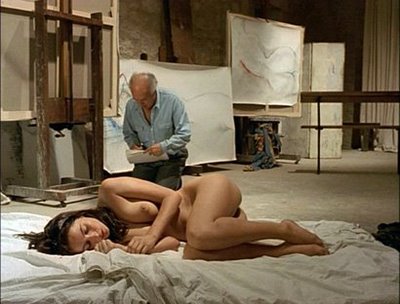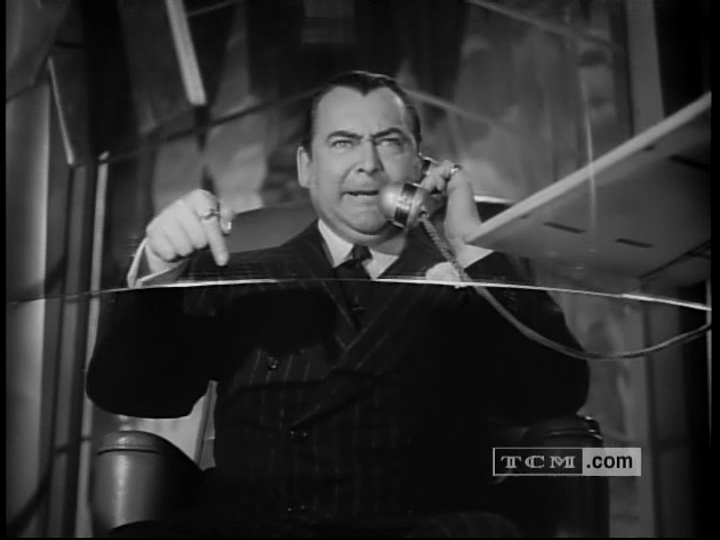From the Chicago Reader (January 8, 1993). — J.R.
A few years ago, world cinema received a shot in the arm from so-called glasnost movies from the former Soviet Union — pictures that had been shelved due to various forms of censorship, mostly political, and were finally seeing the light of day thanks to the relaxation or near dissolution of state pressures. The thought of an American glasnost may seem a little farfetched. But if we start to look at the awesome control exerted by multinational corporations over what we see, particularly in mainstream movies, the definition of what is and isn’t permissible — or, in business terms, what is “viable,” which in this country often comes to the same thing — may seem comparably restricted.
The best movies of 1992 weren’t exactly censored; but given the profound lack of media attention they received they would have achieved much more reality in most people’s minds if they had been. And nothing short of an American-style glasnost would give these films the cultural centrality they deserve. Only three of them received extended theatrical runs in Chicago, and perhaps only one or two got so much as a mention on Entertainment Tonight or in Time, Newsweek, or Entertainment Weekly.
Ignoring the question of distribution and exhibition, reduced state funding for movies in the United States has meant that the amount of talent that’s been obliged to “go underground” — stop work altogether, switch to video, or get funding from abroad — is formidable. The number of talented people who’ve essentially given up doing what they want and chosen profitable film hackwork is comparably large. And if one looks at the talented American moviemakers who’ve continued to make the sort of pictures they want, those who have complete artistic control are few and far between. The major decisions are made by investors and accountants — not even the sort of inspired vulgarians with tastes of their own who used to run the studios, like Louis B. Mayer and Harry Cohn, but figures with no interest in expressing themselves, who care only about balance sheets. Most reviewers are now expected to be balance-sheet tipsters rather than critics, and it’s assumed their basic job is to point their audiences toward the better pieces of junk and away from the worse by pretending that the better ones are artistically significant. Meanwhile most of the U.S. public, not knowing any better, happily assumes that the best and even the most artistic movies come out of the assembly line that gets the media’s full attention.
Though a few artistically important pictures do somehow get made within this impossible system, I’ve found that on the whole they’re fewer and fewer as the years go by. Indeed, as the studios grow increasingly efficient at grabbing our attention for their products, as soon as the opening-week hype wears off the releases themselves quickly recede in interest, usually in one to six weeks. And infotainment is such a dominant force by now that even many of our better reviewers believed that Altman’s The Player — a somewhat classier edition of Premiere, Movieline, and Entertainment Weekly that contrived to give its audience the same deceptive illusion of insider smarts — was somehow a daring attack on the system rather than an integral part of it.
For the first time since I started making these annual lists for the Reader five years ago, not one of the pictures was made in Hollywood; significantly, the three Hollywood pictures that came closest are valuable precisely because they attack the lies, distortions, and perversions of the mainstream media. Unforgiven tackles the abusive rhetoric of the western, Bob Roberts treats the impostures of political campaigning and coverage, and Deep Cover delves into the underside of Bush’s hypocritical “war on drugs.” To my mind they’re slightly less effective than the more thoroughgoing Rock Hudson’s Home Movies — a film shot on video by Mark Rappaport, and the only U.S. movie on my list — but they’re certainly on the right track. Not coincidentally, all three movies exceeded industry expectations, holding on much longer in theaters than anticipated — largely, I would argue, because they said things other Hollywood movies weren’t saying and that needed saying. (For me, the major weakness of Unforgiven, the strongest of this trio, is that it asks us to “reconsider” a romantic cult of macho behavior, including homicide, on which Clint Eastwood founded his own successful career of many years. It’s a cult I never much liked to begin with, and while I’m certainly pleased to discover Eastwood’s belated enlightenment and admire his artistry in expressing it, I don’t see any repudiation of the earlier movies that occasioned this critique, either by Eastwood or by the critics who consider this the year’s best movie.)
1. A Tale of the Wind. One of the more noticeable ways the cold war persists is the almost complete unavailability of the many films of Joris Ivens (1898-1989) in this country; one of the immediate fruits of an American glasnost would be the opportunity to get better acquainted with the work of this prodigious Dutch-born globe-trotter. Only three or four of his 60-odd documentaries are available here on video, none of them made within the last half century. (According to Ephraim Katz’s Film Encyclopedia, Ivens’s “reputation in the West suffered as a result of his self-limiting political commitments” — a neat way of letting us all off the hook by implying that our political commitments have of course never been self-limiting.)
Because his films have been so difficult to find it’s hard to tell how much of Ivens’s final masterpiece (officially French) is the logical outgrowth of his earlier work and how much of it is sui generis. An uncanny essay film made with Ivens’s longtime French companion and collaborator Marceline Loridan, it’s pitched somewhere between documentary and fantasy, lighthearted and profound in about equal measure. This breathtaking visionary work, set almost entirely in contemporary China, has as its central character Ivens himself at the age of 90. His respiratory difficulties and utopian desire to film the wind, the history of cinema, the subtle differences between science and magic (and between history and mythology), the Great Wall of China, and poetic intimations of the present century (belonging to the West) and the next century (belonging to the East) are all lovingly interwoven. As I wrote back in late May, when the film had a brief run at the Film Center, it took four years for this masterwork to reach Chicago, but I doubt whether we’re fully equipped to deal with it even now.
2. Actress. While awaiting a retrospective of the pictures of Ruan Ling Yu (1910-1935), the most celebrated of all silent actresses in the Chinese cinema, I can only recollect with pleasure, admiration, and a certain awe this warm, complex, and multifaceted tribute to her. Stanley Kwan’s Hong Kong masterpiece, which was shown at the Chicago International Film Festival in October, will be returning to Chicago at the Film Center in late March, and the film’s star, Maggie Cheung, will also be putting in an appearance. This is another film that weaves documentary and fiction into a singular fabric of its own, informed by a rare sense of historical curiosity, a lush feeling for big-screen female glamour such as we haven’t seen since George Cukor, and the generous use of archival clips, ingeniously blended with careful color re-creations of Shanghai studio shoots.
At the edges of this dazzling kaleidoscope are video interviews with a few surviving witnesses of Ruan’s brief reign and conversations between Kwan and Cheung about who this unknowable figure might have been. At the vibrant center is Cheung’s exquisite performance; a last-minute replacement for the more “serious” Hong Kong actress Anita Mui, Cheung makes the part completely and indelibly her own. Why Ruan committed suicide is only one of the questions the film chooses to leave partially open; but in the course of asking such questions, Kwan’s talented cowriters, Chiao Hsiung-ping and Qiu Gangjian, open up the past to vast reaches of historical speculation, while Kwan paradoxically encloses that speculation in tight, elegant labyrinths of period decor. Though Actress has a running time of 146 minutes, no film of the past year afforded me more unbridled and continuous pleasure, even after three viewings.
3. Rhapsody in August. Like many of my colleagues, I underrated this masterpiece by Akira Kurosawa (which opened at the Music Box in February), probably because I felt intimidated by the worldwide disdain that’s been expressed for it — a disdain I haven’t shared or understood. It seems unlikely that this film has been denigrated by critics in Japan, Hong Kong, and Taiwan as well as in Europe and United States simply because it deals with an unwelcome subject, the bombing of Nagasaki almost half a century ago. After all, Alain Resnais and Marguerite Duras’ Hiroshima, mon amour (1960) was not received with anything like the same instant dismissal. Some critics spoke of sentimentality, which may be more to the point; but surely Rhapsody in August is no more sentimental than Rashomon or Ikiru, not to mention the more recent Dreams. In his The Postmodernist Always Rings Twice, English writer Gilbert Adair discusses at length a single detail in Rhapsody that for him makes the film “an absolute, half-Griffithian, half-Rossellinian masterpiece”: after the leading character, a small, elderly woman (Sachiko Murase) who survived the Nagasaki explosion, serves her four “youthful, Americanized, gum-chewing” grandchildren an elegant-looking meal, they tell her with some reluctance that they find the food revolting and inedible, and she simply bows her head in response. Adair finds in this tiny gesture the whole beauty of the film writ small; for me, comparable moments of perfection occur when an older sister takes over the cooking and the grandmother returns to serve the kids watermelon slices and, much later, when she and her grandchildren sit on a bench together and look at the moon.
Kurosawa was a little over 80 — a spring chicken next to Ivens — when he made this picture, but the apparent naivete with which he approaches the atomic bomb strikes me as precisely the kind of simplicity that comes only with maturity and wisdom. (Despite the obvious differences, I’m reminded of the comparably despised, neglected, and priceless penultimate features of Fritz Lang, The Tiger of Eschnapur and The Indian Tomb.) Kurosawa’s solidarity with the grandmother’s “unsophisticated” understanding of the bomb has widely been regarded as a pose and an evasion; I’d call it the purest political gesture to be found in any fiction feature I saw all year.
4. A tie between Close-Up and And Life Goes On . . . , the two most recent features of Iranian filmmaker Abbas Kiarostami, both of which received single screenings at the Film Center in October. Each film engages in a different kind of tragicomic juggling act between documentary and docudrama — or between pseudodocumentary and pure fiction, depending on how one chooses to view the material. Close-Up, which follows the exploits, trial, and eventual release of a fanatical fan and impersonator of real-life Iranian filmmaker Mohsen Makhmalbaf, is predicated on the presence of the camera, which creates and defines events, while And Life Goes On . . . , which re-creates a real-life visit to a mountainous area of northern Iran devastated by an earthquake, is predicated on the absence of the camera, at least within the neorealist terms of the story as it’s reenacted. Close-Up is stronger intellectually, as a meditation on the ambiguous power imparted and assumed by “cinema” in modern life, while And Life Goes On . . . is stronger emotionally, as a philosophical look at the ways that ordinary people cope with cataclysmic disasters. The formal power of both films stems largely from what Kiarostami is able to do with long shots, framing his characters and their interactions from enormous distances and obliging us to temper our humanistic sympathy with a certain analytical detachment.
5. The Famine Within. This Canadian feminist documentary by Katherine Gilday concerns the ideological implications of the ideal of feminine beauty that rules our culture; it’s the purest example on my list of the essay film, although properly speaking A Tale of the Wind, Rock Hudson’s Home Movies, As You See, and even (to a limited extent) Actress can and should be regarded as examples too. The essay writer Philip Lopate has cogently argued that essay films should have some of the informal, personal quality of written essays — one reason he prefers Orson Welles’s Filming “Othello,” for instance, to his F for Fake. But my own bias is to admit a much wider range of nonfiction films to the form. True, The Famine Within has a talking-head format like that of conventional documentaries — focusing much of the time on victims of anorexia nervosa and bulimia. But this shouldn’t lead one to underestimate the intellectual and polemical force of this meditation on the ideology of beauty; as the film is organized and developed, it’s about quite a bit more than eating disorders. It played at the Music Box in March and attracted a sizable audience.
6. Rock Hudson’s Home Movies. Mark Rappaport’s hour-long look at Hollywood lies, tics, and conventions uses the resources of fiction — an imagined out-of-the-closet Rock Hudson speaking to us from beyond the grave — as well as film theory to propound its angry, funny, tragic, and pertinent critical observations: this is film criticism in the language of the medium itself. Turning up at the Film Center in November, it showcased the virtues of indexing various behavioral and thematic motifs, as they accumulated over years in Hudson’s work, to make its critical points.
7. Naked Lunch. I’m sure I’d twist myself into a pretzel if I tried to argue that David Cronenberg’s masterful, highly idiosyncratic take on William S. Burroughs’s nonlinear novel was politically correct, any more than most of Burroughs’s writing is. But this dark, claustrophobic, creepily phantasmagoric look at the processes of disavowal as they relate to sex, drugs, and literary creation is surely the most original big-budget studio effort of the past year (it opened at the Esquire and the Broadway in mid-January); everything from the design of the opening credits to the use of Ornette Coleman in the score is admirably conceived and executed. The view of sexuality is unquestionably ugly, but to my mind no worse than what one finds in Cronenberg’s other pictures; for better or worse, such ugliness comes with the territory. (Incidentally, given this picture’s specific, multifaceted relationship to the censorious soul of Ontario, to call it a product of Hollywood rather than Canada is merely to adopt the imperialist attitudes that equate the term “North America” with the United States.)
8. Close My Eyes. Of all the films discussed here, this lyrical and beautifully realized second feature by English playwright Stephen Poliakoff (which ran at the Music Box in February) has perhaps been the most neglected. The unconventional plot–which concerns a brief affair between a grown brother (Clive Owen) and sister (Saskia Reeves) raised separately by different parents and the sister’s marriage to a wealthy entrepreneur (Alan Rickman) — doesn’t give one an adequate idea of the film’s real accomplishment, which is to deal with the sadness and restlessness of Western life in the early 90s. Surely the most difficult kind of “period” film to create is the one that deals evocatively and persuasively with the present; Poliakoff’s achievement is to impart a palpable flavor to the world we inhabit, creating the impression he’s viewing this world wisely and almost apocalyptically, as if from the vantage point of a remote century. (Though there’s nothing at all futuristic about the story, the film conveys some of the elegiac pathos of the late English SF Olaf Stapledon at his best.) The complex and multilayered performances of the three leads, the mood and texture of a hot English summer, and the haunting score by Michael Gibbs combine to produce one of the most wistful portraits of lost possibilities and atrophied emotions since Richard Lester’s Petulia.
9. A tie between Mike Leigh’s Grown-Ups and Harun Farocki’s As You See. I’ve paired these two because both are older films — Grown-Ups was made in 1980, As You See in 1986 — that finally reached Chicago for the first time in 1992, part of touring retrospectives devoted to these two writer-directors. (The English Leigh was honored at the Film Center in January, shortly after Life Is Sweet played at the Music Box, and the German Farocki had a selection of his films shown at Chicago Filmmakers in February, courtesy of the Goethe-Institut.) These titles are high points in fascinating and invaluable careers that deserve to be honored in their entirety — careers that exist largely because of state-financed TV. The fact we don’t have such a thing here undoubtedly helps to explain not only why we don’t find similar work but also why it’s taken so many years for the work of these filmmakers to become known in this country. The exploratory view of culture implied in these works is not that of our mainstream tastemakers.
10. La belle noiseuse. Jacques Rivette’s four-hour look at painterly process, which ran at the Music Box last January and February, has been decried — with some justice — as irrelevant to the way artists actually work and a prurient excuse for an extended peep show. I liked it for its uses of duration (a Rivette specialty), vastly more interesting than Victor Erice’s approach to painting in Dream of Light; for its reflections on artistic creation generally (again, a Rivette specialty if one includes his earlier, metaphorical uses of theater in film); for the performances of Michel Piccoli and Jane Birkin; and, not least, for the power and precision of Rivette’s mise en scene.
Among the many runners-up worth citing are two films that, on reflection, I probably underrated when they first appeared, Night on Earth and Light Sleeper. (On the other hand, I may have slightly overrated Sneakers and All the Vermeers in New York.) Other films that seemed to me underrated or undeservedly neglected, either by other critics or by audiences, include My Love, My Bride (a delightfully inventive Korean comedy), The Hours and Times, King of Chess, Bram Stoker’s Dracula, Edward II, FernGully . . .The Last Rainforest (superior in my opinion to Aladdin, even in its use of Robin Williams, though it didn’t have the hype and muscle of the Disney machine behind it), Noises Off (the year’s funniest farce), North on Evers, Far and Away, Gas, Food, Lodging, Cold Heaven, Samantha, Simple Men, Where the Day Takes You, Laws of Gravity, A Woman’s Tale, Intimate Stranger, Mirror on the Moon, Voices From the Front, and Deadly Currents. Good films that seemed to me overrated — or at least embraced too uncritically — include Hearts of Darkness: A Filmmaker’s Apocalypse (a little too respectful of, even awed by, solipsism and megalomania), Raise the Red Lantern (a consumerist approach to Chinese sexism and feudalism), Proof (a very well crafted piece whose rampant misogyny was overlooked because the film was made by a woman), Glengarry Glen Ross (a very well crafted piece whose rampant piggishness, enhanced by James Foley’s expert uses of ‘Scope and jazz, was overlooked because the script was by David Mamet), and Zentropa (all style and dubious content). Good films that seemed to get more or less what they deserved include Flirting, November Days, White Men Can’t Jump, Reservoir Dogs, My Cousin Vinny, A Midnight Clear, The Waterdance, Husbands and Wives, A Tale of Springtime, Shoot for the Contents, A Brief History of Time, The Hairdresser’s Husband, Locked Up Time, Like Water for Chocolate, and Visions of Light: The Art of Cinematography.
The best revivals were refurbished versions of two masterpieces — Orson Welles’s Othello and Ridley Scott’s Blade Runner. The alleged re-creation of the music and sound effects of Welles’s film in stereo struck me as a significant aesthetic and musical reduction rather than an improvement, but it was wonderful to see Welles’s first independent feature back in circulation. Blade Runner, on the other hand, was undoubtedly improved by some minor additions and major deletions (of the offscreen narration and happy ending), which brought it closer to the director’s original conception. Both films were treated like “art” films, which was understandable with Othello but materially harmful to Blade Runner: the equipment at the Fine Arts simply couldn’t do justice to the movie’s sound track. I would have preferred to see both revivals at McClurg Court, but in any event these rereleases were two of the major film events of the year.
The F.W. Murnau award, given each year to the film or films that did the most to alter my sense of film history, goes this time to the Film Center’s invaluable pioneering retrospective of the neglected writer-director Cy Endfield, whose career — 7 directed features in the United States (1946-1951) and 14 abroad (1953-1971), principally in England — was splintered by the Hollywood blacklist. All seven Endfield features shown at the July retrospective provided revelations of one sort or another. Happily, two more American films by Endfield, both of them uncommonly rare — his very first short, Inflation (1942), and a fascinating low-budget noir thriller, paranoid and slightly delirious, The Argyle Secrets (1948) — will be showing at the Film Center on January 21.

